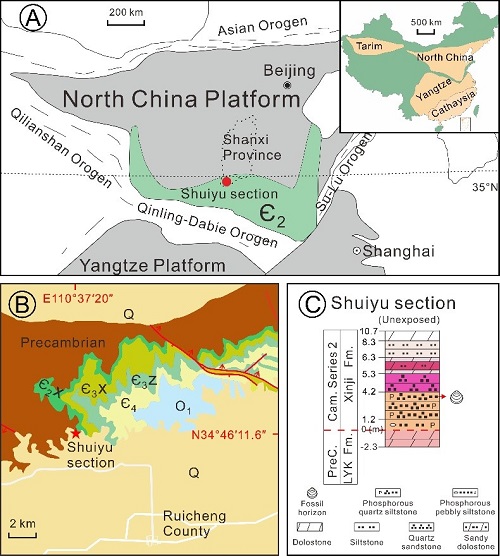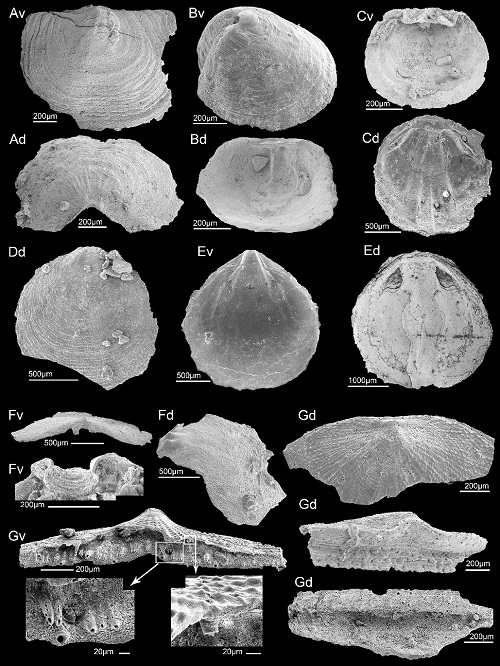In the past several decades, diverse skeletal fossils had been investigated from the Xinji and Houjiashan formations (Cambrian Series 2), along the western and southern margin of North China Plate (NPC). But brachiopods have been scarcely studied from these rocks, and only one brachiopod, Kutorgina sinensis Rong in Lu 1979, was illustrated to date in one Chinese publication.
All other taxa have just been briefly mentioned in stratigraphic descriptions without detailed taxonomic approach. Hitherto, diverse coeval Cambrian organophosphatic brachiopods have been recovered and studied from many other areas, including Australia, Antarctica, South China, Siberia, Greenland, Canada and the United States etc. Thus, systematic research on the organophosphatic brachiopods from North China will be helpful to understand the global distribution and evolution of brachiopods as well as their stratigraphic correlation significance in Cambrian Epoch 2.
Recently, Dr. PAN Bing from Nanjing Institute of Geology and Palaeontology, Chinese Academy of Sciences (NIGPAS) and his international colleagues from Sweden and Australia reported an abundant brachiopod fauna from the Xinji Formation at Shuiyu section, Ruicheng County, Shanxi Province. Related research results have been published in the international journal Palaeoworld.
The brachiopods include one mickwitziid (stem group brachiopoda), Paramickwitzia boreussinaensis n. gen. n. sp., a paterinide, Askepasma toddense Laurie, 1986, an acrotretoid, Eohadrotreta cf. zhenbaensis Li and Holmer, 2004, a botsfordiid, Schizopholis yorkensis (Holmer and Ushatinskaya in Gravestock et al., 2001) and three linguloids, Spinobolus sp., Eodicellomus cf. elkaniiformis Holmer and Ushatinskaya in Gravestock et al., 2001 (recently revised as Plicarmus wildi Claybourn et al., 2020 basing on specimens from Antarctica) and Eoobolus sp..
Paramickwitzia boreussinaensis combines the distinctive characters of Setatella, known from Cambrian Stage 4 in North-East Greenland (pseudointerarea in both valves and the shell penetrating setae on the pseudointerarea) and Mickwitzia (internal cone-shaped projections around the shell perforations). This combination of characters suggests that Paramickwitzia may occupy an intermediate position between Setatella and Mickwitzia in the brachiopod stem group. This brachiopod assemblage suggests a late Age 3 to early Age 4 for the Xinji Formation and reveals a remarkably strong connection with coeval faunas from East Gondwana, particularly the Hawker Group in South Australia.
The fauna shows strong similarities to the coeval (Cambrian Epoch 2) brachiopod faunas of east Gondwana (South Australia and Antarctica, with 4 genera and 4 species in common), South China (2 genera and 1 species in common) and India Himalaya (2 genera in common). This high degree of similarity between the brachiopod faunas from the south margin of North China and east margin East Gondwana (even at species level) further supports a close palaeogeographic position between those two areas during the early Cambrian as indicated by other small shelly fossils data.
This work was supported by grants from the National Natural Science Foundation of China, the Chinese Academy of Sciences and Swedish Research Council.
Reference: Pan, B., Skovsted, C.B., Brock, G.A., Topper, T.P., Holmer L.E., Li, L.Y., & Li, G.X.*, 2020. Early Cambrian organophosphatic brachiopods from the Xinji Formation, at Shuiyu section, Shanxi Province, North China. Palaeoworld, 29, 512–533. https://doi.org/10.1016/j.palwor.2019.07.001.

Geological background map and lithostratigraphic column

The organophosphatic brachiopod assemblage from Cambrian Series 2 Xinji Formation
Contact:
LIU Yun, Propagandist
Email: yunliu@nigpas.ac.cn
Nanjing Institute of Geology and Palaeontology, Chinese Academy of Sciences
Nanjing, Jiangsu 210008, China
Download:
